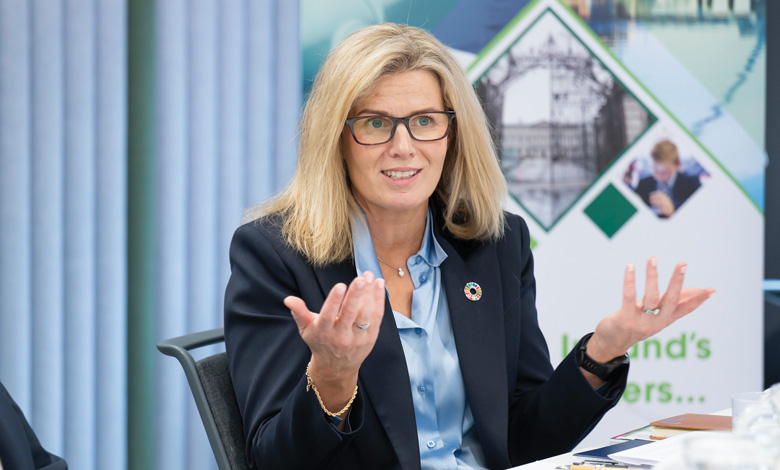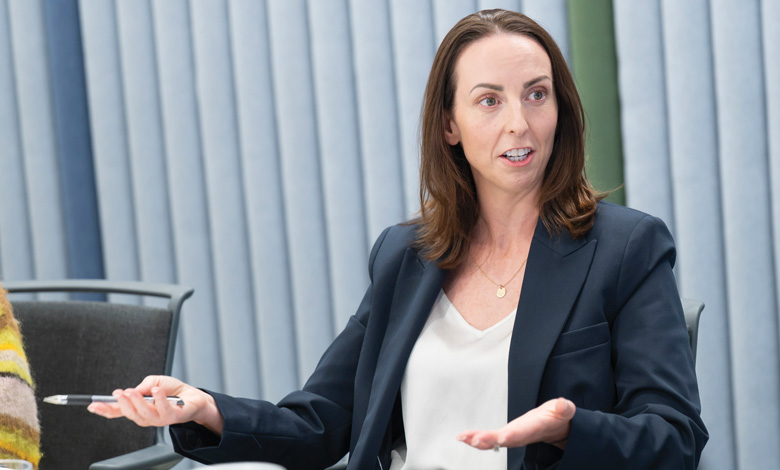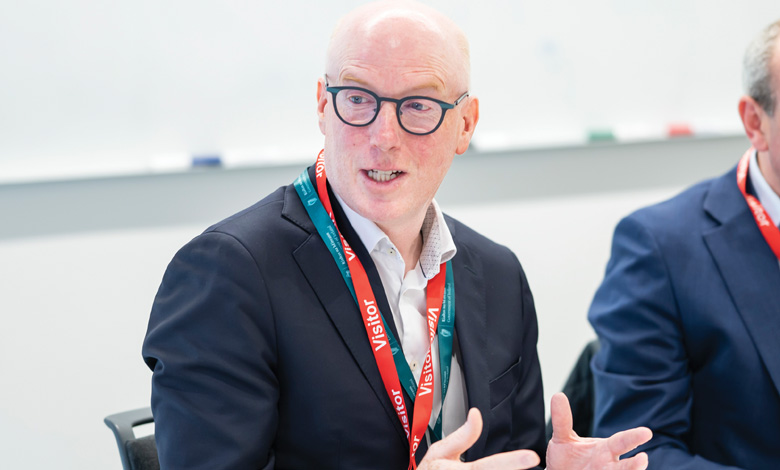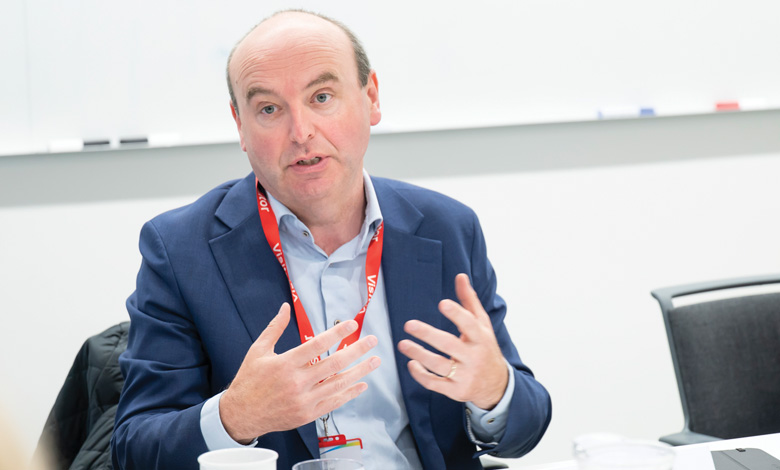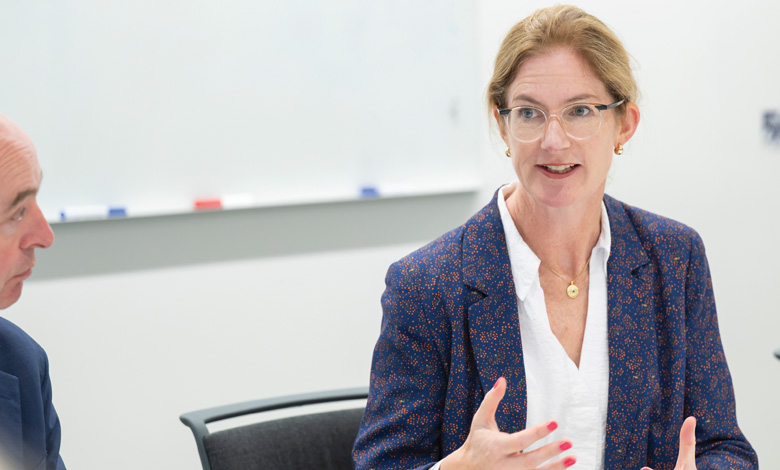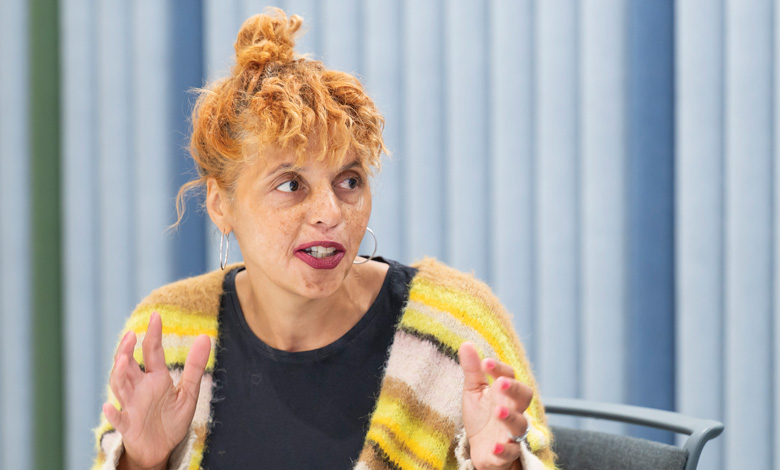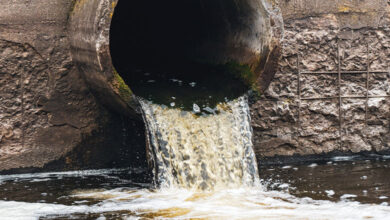Navigating change to deliver sustainability and climate commitments
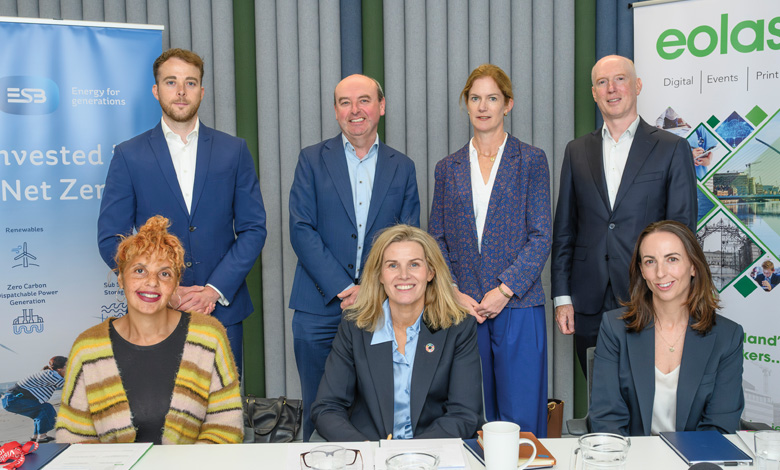
With participants from across the public and the private sectors, ESB hosted a round table discussion to explore the nuances of navigating challenges in delivering sustainability and climate commitments.
To what extent are geopolitical headwinds in sustainability and climate action impacting organisations – whether public or private sector – on the ground?
Sharon McManus

Amid ongoing geopolitical headwinds, most prominently the rhetoric in opposition to ESG observed in the United States, there is a psychological impact on all organisations. However, in ESB, where sustainability is embedded across all strategic activity, there is a resilience, and it remains a central strategic objective. For other organisations where it may not be a primary focus, I would argue that embedding sustainability is a more challenging objective. There is a level of instability in the corporate world following the developments we have seen in the United States. More broadly, however, we should not let this distract from the enormous amount of progress that has been made on sustainability across all sectors, electricity in particular. This conversation should take place with this progress in mind, with a view to how we build on it going forward.
Fergal McParland
There is precedent in that Ireland has already successfully navigated geopolitical headwinds through the energy transition. We have faced serious challenges with Brexit, the Covid pandemic, and the war in Ukraine. We have met these and successfully persisted with delivery of the transition. More broadly, Europe must face prevailing geopolitical challenges by being as Adam Posen put it recently – its “best self”. The energy transition is not a choice, it is an obligation which Europe must continue to lead, and in which Ireland must play its role. Our sustainability policies are embedded in our climate legislation, and this is why Ireland is well-positioned to manage this current headwind.
Fergal O’Brien
The ESG backlash in the United States has had an impact on Ibec’s corporate membership, which comprises many US-based or US-led companies, and there is a challenge on how this is navigated in Ireland and by corporate HQs. The other challenge is the trade war and the uncertainty around how it will impact trade and investment decisions. The ESG backlash means that there is a challenge in that US-based corporate leaders are now hesitant to continue to support sustainability measures. The trade challenge, meanwhile, is a window in time, and we can continue to make long-term decisions with confidence that it will pass.
Lisa Ryan
At a global level, the immediate challenge concerns what happens at the next COP. It is likely that as the US administration will embolden countries which were previously sitting on the fence on their climate commitments. Counterintuitively, the energy security challenge is more positive in that fossil fuels are becoming more expensive and will not be around for much longer, which is why it makes long-term business sense for organisations to invest in clean energy.
Mia Fahey McCarthy
Sustainability was once a concept that had to be sold to people, and now it is embedded in the structures of organisations across both the public and private sectors. However, everything goes in cycles. We are currently at a point where there is a disruption, but the hope lies in the fact that legislation underpins our long-term ambitions which are, in any case, already too embedded in our practices for any short-term disruption to leave a lasting damage.
Eimear Christian
ESG and sustainability are long-term transformation processes for businesses which are too deeply embedded to be structurally damaged by short-term political cycles, such as the ESG backlash in the US. Sustainability is something which must be done because it makes both moral and long-term business sense. The next step which must be taken now is ensuring that these principles are aligned with organisational business strategies, ensuring that progress can be measured. Organisations which are not taking these steps now will not be viable in the next decade, as unsustainable business practices will become economically unviable. Thinking about sustainability with a short-term mindset makes no sense; it requires a long-term view and this is the message that must be articulated.
How can the delivery of critical infrastructure, including renewable energy, be balanced against Ireland’s sustainability considerations?
Fergal O’Brien
Delivering our infrastructure ambitions is the biggest challenge we face nationally if we are to meet our long-term sustainability ambitions. We have a vision for sustainable infrastructure, which is positive. However, we have not yet operationalised this in terms of delivery. We still have robust assessment and legal processes which are built into the system. The core of this is the balance is between the rights of the individual and the public good. The Government introduced planning reforms, but the Planning and Development Act alone is not going to solve the bottleneck of infrastructure ambitions. We must grasp this challenge, or we will not meet our emissions reductions targets.
Eimear Christian
New and old infrastructure need to be considered in tandem. In the near term, slight increases in carbon to facilitate new build needs to be mitigated by deep retrofit of older projects. Delivering infrastructure projects at scale will require the use of energy and increase emissions temporarily, but the delivery of sustainable growth is dependent on this infrastructure being in place. We need full lifecycle assessments to be conducted to demonstrate the absolute GHG emission reductions that can be achieved by new infrastructure if low carbon is built in as a requirement at design stage.
“People are the enabler, and the wider climate and sustainability agenda hinges on community engagement.”
Sharon McManus
Sharon McManus
The emphasis has been on emissions and carbon reduction for a long period of time and that will continue. Our goal is a net zero electricity system by 2040. Delivering infrastructure to make that happen will mean emitting carbon, but the infrastructure being delivered will enable significant emissions reductions in the long term. ESB spent over €2 billion in 2024 alone on critical energy infrastructure, which is essential if we are to reach our national climate goals. We aim to spend another €13 billion over the next five years, supporting the Climate Action Plan and helping secure long-term sustainability for Ireland.
Fergal McParland
It is a whole-of-system challenge because this is about a step-change in how we deliver critical infrastructure to support the energy transition. The Price Review Six (PR6) period is probably the first of successive implementation strategies through which this step-change will be realised. Utility companies have engaged constructively with the Department to support government’s sustainability ambitions. We have seen positive, collective leadership through the work of forums such as the Offshore Wind Delivery Taskforce which includes participation from all the relevant stakeholders. If we are to succeed in the whole-of-system approach, we need engagement processes such as those established through these taskforces.
“ESG and sustainability are… too deeply embedded to be structurally damaged by short-term political cycles…”
Eimear Christian
Lisa Ryan
Critical infrastructure is going to ensure enhanced sustainability and there are some areas where a significantly increased rollout of infrastructure is needed. We are not going to get to net zero emissions without, for example, district heating and we urgently need to make more progress on that. Offshore wind is another area where we need to see progress, as well as wastewater treatment capacity, especially if we are to tackle broad societal challenges such as the delivery of increased housing supply.
Mia Fahey McCarthy
Ireland has the potential to be one of the best places in the world to invest in and deliver clean energy infrastructure. There are so many variables needed to get all our infrastructure projects moving. For example, there are new technologies for refurbishing existing wind turbines which are coming to their end of life. However, the policy frameworks with respect to planning and the enabling infrastructure is not yet there to empower companies to repurpose and repower existing windfarms we already have on the system, and that will be critical to keep on the system in order for the State to meet its 2030 targets.
How do you see sustainability reporting evolving in the future, given developments like the European Commission’s Omnibus legislation?
Fergal McParland
To paraphrase Einstein, everything should be made as simple as possible, but not simpler. This is a good summary of the tactical approach adopted for the Corporate Sustainability Reporting Directive (CSRD). The objective is to simplify sustainability reporting but no simpler than is necessary. The Omnibus package strikes this balance. It will ensure that sustainability targets are met without burdening SMEs. We should see more of that iterative cycle from a legislative perspective from the Commission, whereby the core principles are established and then through iteration the optimal mechanism for implementation is determined. A similar approach has been adopted for CBAM.
“There is a broad social contract dimension to the successful delivery of the energy transition…”
Fergal McParland
Fergal O’Brien
The Omnibus legislation reflects a new sense of urgency from the European Commission in balancing the climate perspective with the competitiveness agenda. The cost of what businesses were being asked to do was not proportionate to the benefit accrued. Sustainability reporting is important, but in the absence of sustainability leaders within SMEs, CEOs and CFOs were being asked to undertake this with incredible administrative costs. Everyone underestimated the scale of professional services costs, and a whole industry emerged around sustainability reporting which was never the objective.
Sharon McManus
ESB is a semi-state, but we are heavily reliant on capital markets to fund our objectives. As such, we require transparent mechanisms which offer prospective investors an insight into our performance. The market is continuing to demonstrate a significant interest in sustainability and nature-related investment. A mechanism like the CSRD is so beneficial to organisations like ESB in that it provides for a level playing field, transparency, and assurance. While the European Commission is now seeking to strike the right balance, one misgiving I have in relation to the Omnibus package is the Corporate Sustainability Due Diligence Directive’s (CSDDD) supply chain aspect. Whether you are reporting under CSDDD or not, we must ensure a strong and stable supply chain.
Eimear Christian
The CSRD, although too complicated, enhanced awareness of risks from a business perspective. It would be unthinkable to see the CSRD vanish entirely so hopefully the Omnibus package will strike an optimal balance for everyone. Sustainability reporting is not new, rather the CSRD was an attempt to make it mainstream and comparable for financiers who want enhanced transparency around sustainability to inform their investment decision-making. To some extent, the markets will dictate the future of sustainability reporting, and it is likely that transparency will prevail. In time companies will realise there are numerous reasons to report on climate risk and resilience that go far beyond compliance.
Mia Fahey McCarthy
As Eimear says, we have been reporting against several sustainability frameworks for many years, though perhaps none as onerous as CSRD which is why they have not received the same attention. Nobody can argue that we do not need a transparent framework against which to compare companies’ sustainability performances. Ultimately, whichever way the Omnibus package lands, it must deliver a consistent mechanism that avoids undermining sustainability professionals.
Lisa Ryan
The ESG movement has brought the sustainability agenda into the boardroom, to companies, to areas of companies which are not involved in energy. I was concerned when I heard that CSRD was being reappraised. It is important that there is transparency around corporate sustainability – it enables companies to demonstrate that they are performing well and ultimately reduces greenwashing. Among colleagues in Smurfit Business School, there is an interest in the metrics of ESG, and their students are then bringing this knowledge into all areas of the economy. In that context, we must retain a transparent – though simplified – reporting framework.
How can we better engage the public on sustainability and net zero, to deliver change while ensuring a just transition?
Mia Fahey McCarthy
When discussing climate action and the net zero transition, we are often communicating with communities. Jargon means nothing to communities. We must communicate in a language that people can understand to bring people with us on the journey. SSE cannot operate without social or community acceptance and, in its absence, we would have a difficult road ahead in delivering new infrastructure. It is paramount that local communities see the benefits of these new infrastructure projects and of the energy transition more broadly, be that through local economic contributions of these projects, as well as employment and reskilling opportunities in new, cutting-edge and growing sectors. We must understand people’s sense of place and invest in infrastructure in a manner that minimises disruption, recognising that sometimes disruption is inevitable.
“Delivering our infrastructure ambitions is the biggest challenge we face nationally…”
Fergal O’Brien
Lisa Ryan
One thing we know is that simply appealing to people to do good – and invest in a technology for the benefit of others – is not a one-size-fits-all solution. However, technologies that are mutually beneficial for the environment and individuals – such as solar panels – work particularly well. At the same time, we must ensure that price signals are fair. For example, if we are going to increase the cost of fossil fuel cars, we must ensure that a cheaper, viable public transport alternative exists. Price signals must also avoid being regressive and disproportionately affecting lower-earning cohorts of the population. For instance, they can be offset via mechanisms that redistribute revenue via social welfare, retrofits, or climate projects. Price signals must also be accompanied by information to ensure that people understand what is happening. It takes a long time for populations to get used to a new idea.
Fergal O’Brien
We do not talk enough about economic sustainability, for example, the economic sustainability of agriculture. Many holdings will not be economically viable unless we address the climate and sustainability challenge. We must also better integrate our energy and industrial policies. In the next phase of industrial development, a major component will be energy. This will entail a substantive and economically sustainable transformation of regions. For example, the Shannon Estuary Economic Taskforce demonstrated excellence in terms of engaging a community and selling the economic development potential of the Shannon Estuary region.
“The ESG movement has brought the sustainability agenda into the boardroom.” Lisa Ryan
Sharon McManus
In ESB, we want to move forward to a scenario in which communities recognise the benefits that the delivery of our infrastructure can bring to their regions through community benefit funds, job creation, and industrial development. People are the enabler, and the wider climate and sustainability agenda hinges on community engagement. The work of the Shannon Estuary Economic Taskforce is an exemplar of what can be achieved. Regarding communication, in the past our messaging may have been too complex at times – we need to simplify this and pivot emphasis away from the individual and towards the collective.
Fergal McParland
There has been a step change in public discourse around infrastructure delivery. How agencies and developers are now working with communities in terms of effectively communicating the benefits of infrastructure projects has been transformational. However, there is a broad social contract dimension to the successful delivery of the energy transition that must be continuously articulated if we are to be successful. The fundamentals of community gain are now established in government policy, and the enhanced visibility of these principles via the consultative strategies of agencies and developers is a critical cornerstone for success.
Eimear Christian
One of Uisce Éireann’s current initiatives is to educate one million people on the value of water by 2030. We want people to engage and understand that water is a finite resource and that we have a collective responsibility for what is a shared resource. Consistent leadership and messaging around water infrastructure is essential to avoid undermining public opinion.
What opportunities exist for organisations to simultaneously enhance competitiveness while delivering sustainability and climate commitments?
Sharon McManus
Energy security is critical for our economic and national security. We are operating in a period of great uncertainty, and we must be comfortable with that. The opportunity for Ireland is immense, especially if we can ensure energy security through our abundant indigenous resources like wind power. It will be a challenge getting to that point, but it will unlock so much potential. Collaboration is the key to this journey, which means that opportunities exist for all organisations.
Fergal O’Brien
We are in a phase where the energy trilemma is coming into sharper focus in terms of affordability, security, and sustainability. We must have a more transparent conversation on competitiveness and cost; deciding who will pay for the net zero transition. These are the questions business leaders are consistently raising. We all know that there will be a cost to this, but there is no definitive answer as to what this cost will total.
“Nobody can argue that we do not need a transparent framework against which to compare companies’ sustainability performances.”
Mia Fahey McCarthy
Eimear Christian
The focus needs to be on collaboration rather than competitiveness when looking through an ESG lens. The only way to deliver climate commitments is by working together. Cost is a huge challenge for climate adaptation because there is a high level of uncertainty as to who will pay for it. Delays in approving large infrastructure projects will impact our overall competitiveness as a country to attract FDI as well as our ability to simply service organic growth. The Water Supply Project is an example of a critical project that needs to be expedited through the planning process. Getting the project off the ground will create enormous socioeconomic opportunities right across the country, but if we are to make progress, we must communicate the importance of this project and ensure that we bring the public on the journey with us.
Lisa Ryan
Climate change and sustainability investment is a long-term project for any organisation, and we must encourage organisations to understand these investments in that context. Energy efficiency is a classic example; there is a high upfront cost but a considerable long-term gain. We need to be transparent about costs, and the reality is that there will be costs either way; continuing to use fossil fuel energy will be expensive and will not guarantee energy security, whereas pursuing sustainability measures will ensure our long-term competitiveness.
Fergal McParland
There are considerable opportunities established through policy. Minister O’Brien recently showcased SEAI’s grants for SMEs for business energy upgrades, including the Non-Domestic Micro-generation Support Scheme (MSS), which allow for sustainable energy use to be embedded at SME level. The grants are available and SEAI is ensuring that those policy objectives are met, helping to bring communities on this journey with us.
Mia Fahey McCarthy
The key to making progress is enhancing supply chains, which will bring benefits to large businesses and SMEs alike and the collaboration opportunity emanates from that. For example, SSE recently held a stakeholder event with our suppliers to ensure that SMEs were properly informed in developing their own climate action plans. It is about seeing sustainability initiatives as a whole-picture piece and bringing all stakeholders right across the supply chain with us.

